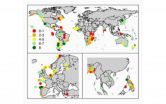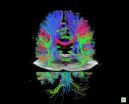The LCS team of researchers led by Mather included graduate student Xiaofan Luo and undergraduate student Andrew DiOrio.
Syracuse University team develops functionally graded shape memory polymers
2011-01-06
(Press-News.org) A team led by Patrick T. Mather, director of Syracuse Biomaterials Institute (SBI) and Milton and Ann Stevenson professor of biomedical and chemical engineering in Syracuse University's L.C. Smith College of Engineering and Computer Science (LCS), has succeeded in applying the concept of functionally graded materials (FGMs) to shape memory polymers (SMPs).
SMPs are a class of "smart" materials that can switch between two shapes, from a fixed (temporary) shape to a predetermined permanent shape. Shape memory polymers function as actuators, by first forming a heated article into a temporary shape and cooling. Then, by using a second stimulus (i.e. heat), the article can spring back to its original shape.
To date, SMPs have been limited to two-way and three-way shape configurations. Mather has successfully built a process where sections of one shape memory polymer independently react to different temperature stimuli. This work has been highlighted on the cover of the January 2011 issue of Soft Matter, the leading journal in the field of soft matter research.
Functionally graded materials are defined as synthetic materials where the composition, microstructure and other properties differ along sections of the material. The goal of Mather's research was to apply this theory to SMPs and create a material that could be fixed and recovered in one section without impacting the response of the other sections.
Mather created a temperature gradient plate by applying heat at one end and using a cooling unit at the other end. The actual temperature gradient was verified by measuring different positions along the plate. The SMP was cured on this plate to set the different transition temperatures.
Mather first tested the graded SMP by using micro-indention on the surface and then heating the polymer. When heated, each indentation recovered to the original smooth surface as each one's transition temperature was reached along the surface.
The second test involved cutting the SMP and bending back the cut sections. This SMP was placed on a Pelletier plate that uniformly heated the material. It was observed that as the plate warmed, each "finger" of the cut sheet independently recovered back to its unbent shape as the temperature of the plate reached its transition temperature.
"We are very excited about this new approach to preparing shape memory polymers, which should enable new devices with complex mechanical articulations," says Mather. "The project demonstrated how enthusiastic and persistent undergraduate researchers could contribute substantively, even in the throes of their busy course schedules."
There are numerous applications opportunities for Mather's functionally graded SMPs, from low-cost temperature labels that could measure temperatures in areas that are not accessible by conventional methods or not amenable to continuous monitoring, to indirectly indicate sterilization completions, or for incorporation into product packaging (for shipping industry or food storage) to indicate the maximum temperature for a product exposure.
INFORMATION:
ELSE PRESS RELEASES FROM THIS DATE:
Widespread ancient ocean 'dead zones' challenged early life
2011-01-06
The oceans became oxygen-rich as they are today about 600 million years ago, during Earth's Late Ediacaran Period. Before that, most scientists believed until recently, the ancient oceans were relatively oxygen-poor for the preceding four billion years.
Now biogeochemists at the University of California-Riverside (UCR) have found evidence that the oceans went back to being "anoxic," or oxygen-poor, around 499 million years ago, soon after the first appearance of animals on the planet.
They remained anoxic for two to four million years.
The researchers suggest that ...
Newly developed cloak hides underwater objects from sonar
2011-01-06
CHAMPAIGN, Ill. — In one University of Illinois lab, invisibility is a matter of now you hear it, now you don't.
Led by mechanical science and engineering professor Nicholas Fang, Illinois researchers have demonstrated an acoustic cloak, a technology that renders underwater objects invisible to sonar and other ultrasound waves.
"We are not talking about science fiction. We are talking about controlling sound waves by bending and twisting them in a designer space," said Fang, who also is affiliated with the Beckman Institute for Advanced Science and Technology. "This ...
Globally sustainable fisheries possible with co-management
2011-01-06
The bulk of the world's fisheries--including the kind of small-scale, often non-industrialized fisheries that millions of people depend on for food--could be sustained using community-based co-management. This is the conclusion of a study reported in this week's issue of the journal Nature.
"The majority of the world's fisheries are not--and never will be--managed by strong centralized governments with top-down rules and the means to enforce them," says Nicolas Gutiérrez, a University of Washington fisheries scientist and lead author of the Nature paper.
"Our findings ...
Violence against mothers linked to 1.8 million female infant and child deaths in India
2011-01-06
Boston, MA -- The deaths of 1.8 million female infants and children in India over the past 20 years are related to domestic violence against their mothers, according to a new study led by researchers at the Harvard School of Public Health (HSPH). In their examination of over 158,000 births occurring between 1985 and 2005, the researchers found that husbands' violence against wives increased the risk of death among female children, but not male children, in both the first year and the first five years of life.
"Being born a girl into a family in India in which your mother ...
Mayo Clinic determines lifetime risk of adult rheumatoid arthritis
2011-01-06
ROCHESTER, Minn. -- Mayo Clinic researchers have determined the lifetime risk of developing rheumatoid arthritis and six other autoimmune rheumatic diseases for both men and women. The findings appear online in Arthritis and Rheumatism.
VIDEO ALERT: Additional audio and video resources, including excerpts from an interview with Cynthia Crowson describing the research, are available on the Mayo Clinic News Blog(http://newsblog.mayoclinic.org/2011/01/05/whats-your-risk-of-developing-rheumatoid-arthritis/)
"We estimated the lifetime risk for rheumatic disease for both ...
Consumers prefer products with few, and mostly matching, colors
2011-01-06
COLUMBUS, Ohio – Most people like to play it safe when combining colors for an article of clothing or outfit, a new study suggests.
When consumers were asked to choose colors for seven different parts of an athletic shoe, they tended to pick identical or similar colors for nearly every element.
They usually avoided contrasting or even moderately different color combinations.
A red and yellow athletic shoe? Not going to happen. Blue and grey? That's more like it.
This is one of the first studies to show how consumers would choose to combine colors in a realistic ...
Major advance in MRI allows much faster brain scans
2011-01-06
An international team of physicists and neuroscientists has reported a breakthrough in magnetic resonance imaging that allows brain scans more than seven times faster than currently possible.
In a paper that appeared Dec. 20 in the journal PLoS ONE, a University of California, Berkeley, physicist and colleagues from the University of Minnesota and Oxford University in the United Kingdom describe two improvements that allow full three-dimensional brain scans in less than half a second, instead of the typical 2 to 3 seconds.
"When we made the first images, it was unbelievable ...
UConn cardiologists uncover new heart attack warning sign
2011-01-06
Cardiologists at the University of Connecticut Health Center have identified a protein fragment that when detected in the blood can be a predictor of heart attack.
Their research, led by Dr. Bruce Liang, director of the Pat and Jim Calhoun Cardiology Center, is published in the Jan. 11 issue of the Journal of the American College of Cardiology. It found heart attack patients had elevated levels of the protein fragment known as Caspase-3 p17 in their blood.
"We've discovered a new biomarker for heart attack, and showed that apoptosis, or a particular kind of cell death, ...
Scientists now know why some cancers become malignant and others don't
2011-01-06
Cancer cells reproduce by dividing in two, but a molecule known as PML limits how many times this can happen, according to researchers lead by Dr. Gerardo Ferbeyre of the University of Montreal's Department of Biochemistry. The team proved that malignant cancers have problems with this molecule, meaning that in its absence they can continue to grow and eventually spread to other organs. Importantly, the presence of PML molecules can easily be detected, and could serve to diagnose whether a tumor is malignant or not.
"We discovered that benign cancer cells produce the ...
School-based interventions for obesity
2011-01-06
St. Louis, MO, January 6, 2011 – Thanks to the Let's Move initiative, society is becoming more aware of alarming statistics like 1 in 4 children are obese and childhood obesity has nearly doubled over the past two decades! With this platform, nutrition education and physical activity in the classroom have taken the forefront against this growing epidemic. A study in the January/February 2011 issue of the Journal of Nutrition Education and Behavior explores twenty-six school-based nutrition interventions in the United States.
Investigators performed a content analysis ...




